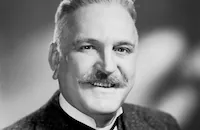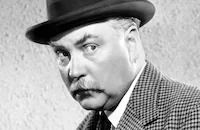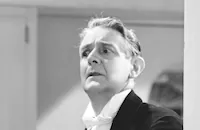The Last of Mrs. Cheyney

Brief Synopsis
Cast & Crew
Richard Boleslawski
Joan Crawford
William Powell
Robert Montgomery
Frank Morgan
Jessie Ralph
Film Details
Technical Specs

Synopsis
When Francis, Lord Kelton, finds a beautiful woman in his stateroom, he is flustered, but his playboy friend, Arthur, Lord Dilling, is fascinated by her. He finds out from the ship's purser that she is American widow Fay Cheyney on her way to stay in England. In London, she becomes the darling of English society, impressing everyone, including Arthur's wealthy aunt, the Duchess of Ebley, who invites her to stay with her for the weekend. Arthur tries to impress Fay, but is rejected by her, even though she is becoming attracted to him. After a charity auction at Fay's house, her "servants" look forward to a profitable future, but Charles, her butler, suggests that she may be more fond of Arthur than she pretends. Fay and her servants are really confidence operators who are planning a jewel robbery, using Fay as their front. At the duchess' country home, she suggests to Fay that Arthur, who usually acts like a cad, is really in love with her, but Fay shrugs her words off. After Lord Kelton makes a bungled attempt to propose to her, Fay sneaks into the duchess' room and attempts to steal her pearl necklace, but is interrupted by a maid. Before she can resume, Arthur also interrupts and proposes. In London, the servants worry about Fay's lack of success, while, in the country, Fay learns how to get into the duchess' safe, but finds it difficult to think of robbing her because of her kindness. Soon Charles arrives, but tells Fay that she can't get out of the plan now because of the others. Before he leaves, she decides to continue, even though Charles offers to face the others himself, and tells him that she will signal him when she has the duchess' pearls. Arthur sees Charles sneaking around the grounds and tries to have him stay the night, suspecting that he has seen Charles somewhere before, but Charles leaves. Later, when Fay steals the pearls, Arthur confronts her before she can throw them down to her friends, after remembering that he recognized Charles from an incident the previous year on the Riviera. He tries to blackmail her into spending the night with him, but she refuses, saying that she has never done that before. She then rings the alarm, rousing the entire household. He tries to take the blame, saying he acted like a cad, but she produces the pearls and tells them all the truth. When Charles arrives, he summons the police, using Arthur's name, and they wait for Inspector Witherspoon of Scotland Yard's arrival the next morning. At breakfast, Arthur reveals that a letter that Lord Kelton wrote to Fay describing his friends may have to be used in court. Though at first amused, they are shocked when they learn that Kelton has written the unexpurgated truth about all of them. Kelton then suggests that they offer to pay Fay's passage back to America in exchange for not revealing the letter's contents. Fay, however, finds the offer too "dishonorable," until Kelton finally offers £10,000. She has destroyed the letter already, though, and will not take the money. In gratitude, Kelton offers to set Fay up with a modiste shop and the others offer to be her clients, but she again refuses. Though she wants Charles to stay, he declines, saying that he would have to remain honest if he stayed with her. After offering to return Arthur's watch, which he stole five years before, he goes with Inspector Witherspoon, leaving Fay ignorant of the fact that he has turned himself in. When everyone has gone, Arthur says that he has arranged for them to be married by a neighboring bishop that morning, marking the last of Mrs. Cheyney and the first of Lady Dilling.

Director

Richard Boleslawski
Cast

Joan Crawford

William Powell

Robert Montgomery

Frank Morgan

Jessie Ralph

Nigel Bruce
Colleen Clare

Benita Hume

Ralph Forbes
Aileen Pringle

Melville Cooper

Leonard Carey

Sara Haden
Lumsden Hare
Wallis Clark
Barnett Parker
Robert Cory
Thomas A. Braidon
Vesey O'davoren
Wilson Benge
Crew
Adrian
Dorothy Arzner
Dr. William Axt
George Fitzmaurice
George Folsey
Cedric Gibbons
Leon Gordon
Monckton Hoffe
George Oppenheimer
Samson Raphaelson
Douglas Shearer
Frank Sullivan
Lawrence Weingarten
Edwin B. Willis
Edward Woehler
Joseph Wright

Photo Collections
Videos
Movie Clip



Trailer
Film Details
Technical Specs

Articles
The Last of Mrs. Cheyney (1937)
Even though she was still popular, Crawford's two films released in 1936 had been departures for her -- The Gorgeous Hussy was a historical drama, and Love on the Run was a screwball comedy - and had not done as well as her earlier films, which were dubbed "Shopgirls' Delights" because Crawford played ambitious working class heroines much like herself. But instead of heeding the warning signs, M-G-M again cast her against type in The Last of Mrs. Cheyney, a drawing room comedy in which Crawford played a glamorous jewel thief. Based on British playwright Frederick Lonsdale's 1925 play, it had first been filmed in 1929 as an early talkie starring Norma Shearer and Basil Rathbone. Fay Cheyney passes herself off as a society lady, and pulls off her heists at aristocratic house parties with her accomplice (William Powell), who poses as a butler. The story takes place at a weekend gathering, where she's wooed by a titled gentleman (Robert Montgomery), and schemes to steal a necklace belonging to her good-natured hostess (Jessie Ralph).
In late 1936, Crawford had been cast - or, more accurately, miscast - as Clark Gable's love interest in the historical drama, Parnell (1937), but she balked at doing the film. So she traded roles with Myrna Loy, who had originally been slated to star in The Last of Mrs. Cheyney. Russian director Richard Boleslawski, who had studied at the famed Moscow Art Theater with Stanislavsky, had been an actor and teacher of Stanislavsky's Method in New York, would direct The Last of Mrs. Cheyney. He had been in Hollywood since 1929, and had directed everything from melodramas to screwball comedies. A few weeks before the end of production on The Last of Mrs. Cheyney, Boleslawski died suddenly of a heart attack at the age of 47. George Fitzmaurice was assigned to finish the film, but he became ill, and Dorothy Arzner ended up with the assignment.
The Last of Mrs. Cheyney was the only film that co-starred Crawford and Powell. They were not well matched. While Powell was at ease with the film's brittle comedy, Crawford wasn't, and the two stars did not have chemistry together. Montgomery's breezy All-American comedy style was also not quite right for his role as a British aristocrat. According to Time magazine, "The acting required for this kind of comedy, as stylized and polished as that of Chinese tragedy, is not precisely the brand at which Montgomery, Crawford, et al, are specialists. Nonetheless...[it] retains the pleasantly dry flavor of Author Lonsdale's wit." But Time's critic still found it "one of the most refreshing comedies of the season." The Last of Mrs. Cheyney did moderately well at the box office, but not well enough to boost Crawford's sagging popularity.
Her next film, The Bride Wore Red (1937), also directed by Dorothy Arzner, was less favorably received. Still, M-G-M signed Crawford to a new contract in 1938. Over the next few years she had two great roles, as the scheming mantrap Crystal in The Women (1939), and as a bitter woman with disfiguring facial scars in A Woman's Face (1941). She had to fight for both roles, but by the early 1940s, she was tired of fighting, and there were more mediocre films than good ones. In 1943, Crawford and M-G-M studio head Louis B. Mayer agreed that it was time for her to go. The ever-resilient Crawford re-invented herself once again, moving to Warner Bros. and winning an Oscar® for her first starring role there, in Mildred Pierce (1945).
As for Mrs. Cheyney, she also had another chance. The Last of Mrs. Cheyney was remade in 1951 as The Law and the Lady with Greer Garson in the title role. But it, too, did little for the career of its fading star.
Director: Richard Boleslawski, George Fitzmaurice, Dorothy Arzner
Producer: Lawrence Weingarten
Screenplay: Leon Gordon, Samson Raphaelson, Monckton Hoffe, based on the play by Frederick Lonsdale
Cinematography: George Folsey
Editor: Frank Sullivan
Costume Design: Adrian
Art Direction: Cedric Gibbons
Music: William Axt
Cast: Joan Crawford (Fay Cheyney), Robert Montgomery (Lord Arthur Dilling), William Powell (Charles), Frank Morgan (Lord Kelton), Nigel Bruce (Sir William), Jessie Ralph (Duchess), Benita Hume (Kitty), Melville Cooper (William), Ralph Forbes (John), Aileen Pringle (Marie).
BW-99m. Closed captioning.
by Margarita Landazuri

The Last of Mrs. Cheyney (1937)
The Last of Mrs. Cheyney (1937)
As the widowed Fay Cheyney, Crawford charms her way into London society for the purpose of relieving British socialites of their baubles. William Powell plays her partner in crime, a supposed butler called Charles, and Robert Montgomery is Lord Dilling, a young nobleman who dallies with Fay while working his own angles. When Fay is revealed as a thief, she finds an ingenious way of wriggling out of her difficulties.
Myrna Loy was originally scheduled to play Mrs. Cheyney, while Crawford had been set for Parnell, opposite Clark Gable. After Crawford experienced "creative differences" with Parnell director John M. Stahl, the two actresses exchanged roles.
Tragedy struck this production of Mrs. Cheyney when its director, Richard Boleslawski, died of a heart attack midway through filming. When his replacement, George Fitzmaurice, also fell ill, Dorothy Arzner -- one of the very few female directors in the days of the Hollywood studio system -- stepped in to complete the movie. Arzner's efforts led to a contract with MGM, although she directed only one more film there: another Crawford vehicle, The Bride Wore Red (1937). Crawford and Arzner had gotten along well during Mrs. Cheyney, but their relationship on the follow-up film was so strained that they eventually communicated only through written messages delivered by a third party, MGM publicist Maxine Thomas.
Powell, a master of the drawing-room style, took the acting honors for The Last of Mrs. Cheyney, but Crawford did receive some good notices for her uncharacteristic effort at high-style comedy. She was at a turning point in her MGM career, being dubbed "First Queen of the Movies" by Life magazine in 1937 but about to be named the following year as "box office poison" by motion picture exhibitors.
Producer: Lawrence Weingarten
Director: Richard Boleslawski, George Fitzmaurice (uncredited), Dorothy Arzner (uncredited)
Screenplay: Leon Gordon, Samson Raphaelson, Monckton Hoffe, George Oppenheimer (uncredited), from play by Frederick Lonsdale
Cinematography: George Folsey
Editing: Frank Sullivan
Original Music: Dr. William Axt
Art Direction: Cedric Gibbons
Costume Design: Adrian
Cast: Joan Crawford (Mrs. Fay Cheyney), William Powell (Charles), Robert Montgomery (Lord Arthur Dilling), Frank Morgan (Lord Francis Kelton), Jessie Ralph (The Duchess of Ebley), Nigel Bruce (Lord Willie Winton), Benita Hume (Lady Kitty Winton).
BW-99m. Closed captioning.
by Roger Fristoe
The Last of Mrs. Cheyney (1937)
Quotes
Trivia
Arzner was the 3rd director George Fitzmaurice took over directing when Richard Boleslawski died suddenly. When he became ill, Dorothy Arzner finished directing the movie.
The play opened in London, England, UK on 22 September 1925.
A New York City, New York, USA production opened on 9 November 1925 and had 385 performances. In the cast were Helen Hayes, Roland Young, Winifred Harris and Lionel Pape.
Myrna Loy was originally cast as Fay Cheyney, while Joan Crawford was cast in 'Parnell (1937)' . Because Crawford did not like her role in Parnell, she switched roles and films with Loy.
Wilson Benge is listed in studio records as "Butler", but he did not appear in the released movie.
Notes
Richard Boleslawski died at age forty-seven of a heart attack on January 17, 1937, prior to the completion of this film. According to news items, George Fitzmaurice was given the assignment to finish the remaining days of shooting after a temporary halt in production, however, Fitzmaurice became ill and Dorothy Arzner was then given the assignment to finish the picture. The extent of Fitzmaurice or Arzner's work that is included in the released film has not been determined. According to pre-release news items, Joan Crawford took over the role of Mrs. Cheyney when she decided to leave the cast of Parnell over creative differences with director John M. Stahl. At that time, Myrna Loy was assigned Crawford's role in Parnell and Crawford took over Loy's role in this film. Frederick Lonsdale's play, which had a very successful run in London and in New York, where it opened on November 9, 1925, was previously adapted for the screen in 1929 by Sidney Franklin for M-G-M, starring Norma Shearer and Basil Rathbone (see AFI Catalog of Feature Films, 1921-30; F2.2978). Miriam Hopkins portrayed Mrs. Cheyney on a Lux Radio Theatre broadcast on March 16, 1936, and Walter Pidgeon and Adolphe Menjou played the male roles in a Lux Radio Theatre broadcast on May 11, 1942. Later versions of the story included a 1951 M-G-M picture entitled The Law and the Lady, directed by Edwin H. Knopf, with Greer Garson and Michael Wilding, a 1953 public television play and a 1961 German film entitled Frau Cheyney's Ende.















